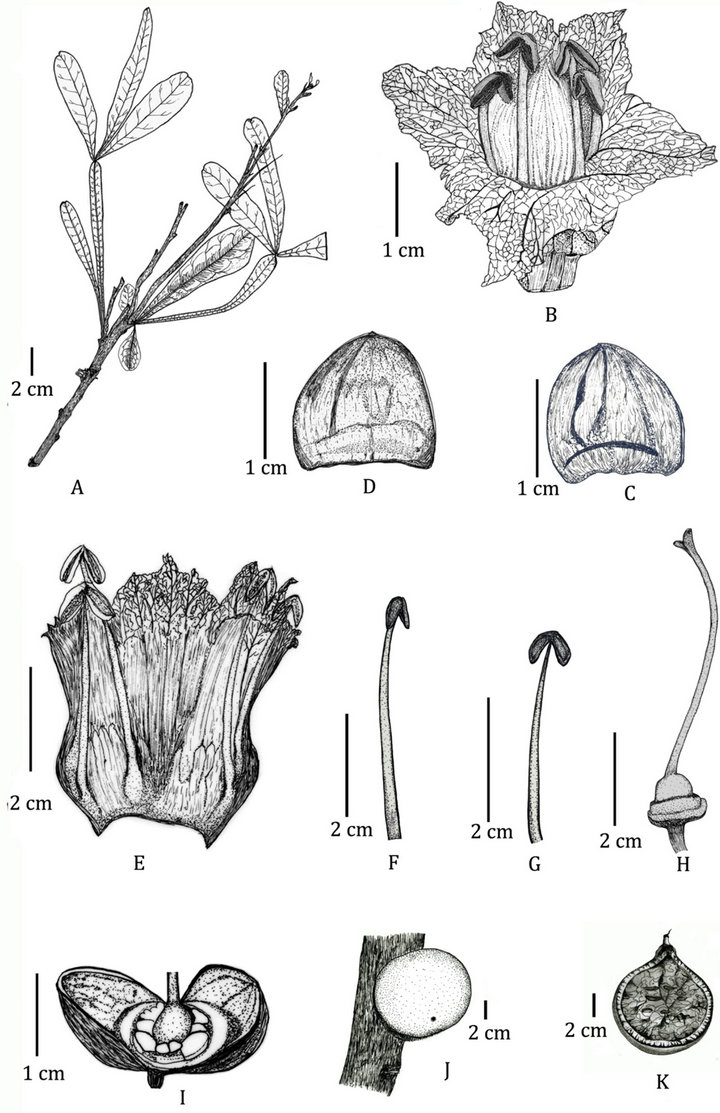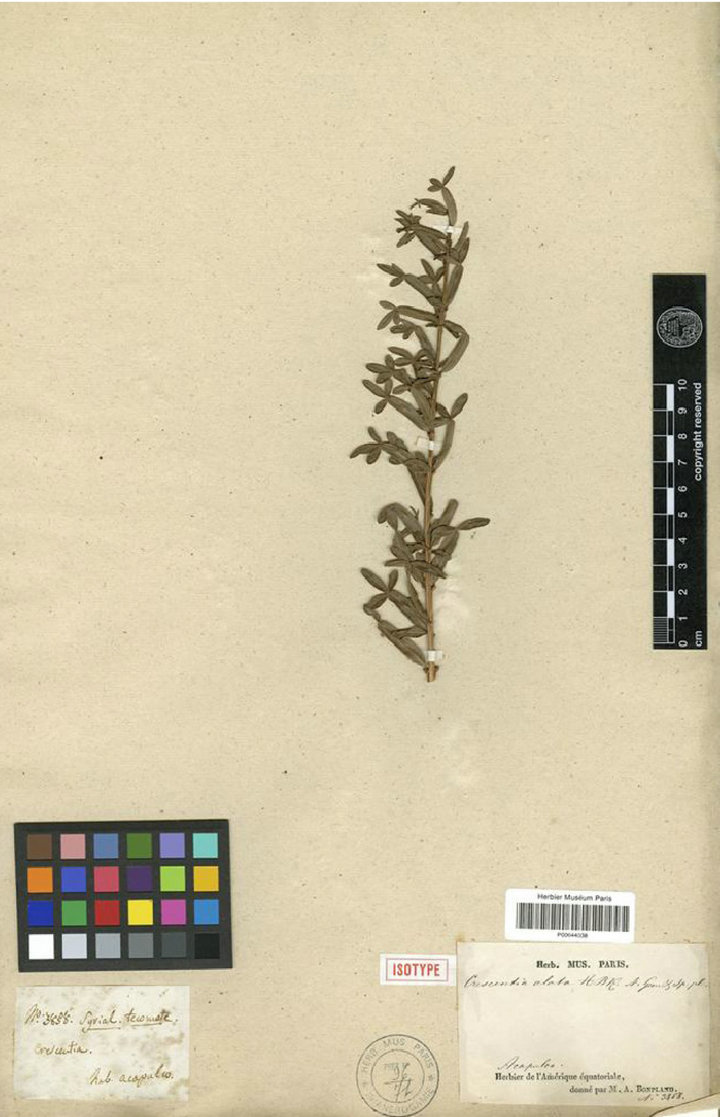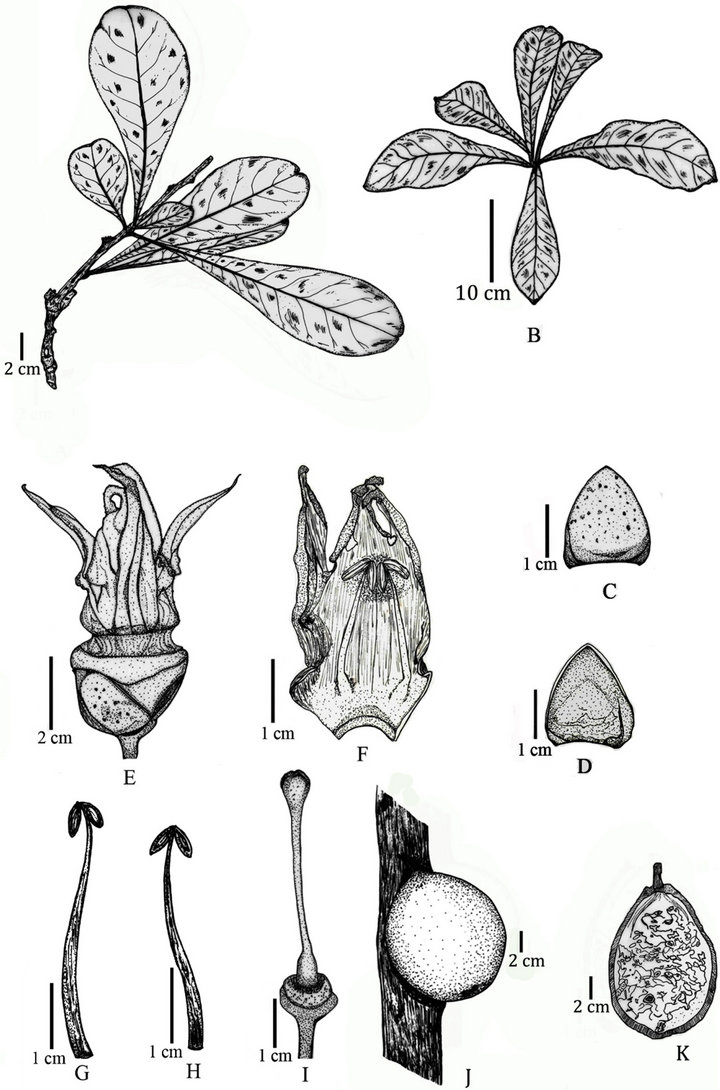American Journal of Plant Sciences
Vol.4 No.6(2013), Article ID:32719,5 pages DOI:10.4236/ajps.2013.46143
Revision of Genus Crescentia L. (Bignoniaceae) in India
![]()
1Botanical Survey of India, NRC, Dehradun, India; 2Banaras Hindu University, Varanasi, India.
Email: *skshri08@rediffmail.com
Copyright © 2013 Virendra K. Madhukar et al. This is an open access article distributed under the Creative Commons Attribution License, which permits unrestricted use, distribution, and reproduction in any medium, provided the original work is properly cited.
Received March 12th, 2013; revised April 15th, 2013; accepted May 10th, 2013
Keywords: Crescentia; Bignoniaceae; Revision; Taxonomic; India
ABSTRACT
The genus Crescentia L. in India is taxonomically revised. A key to the species, nomenclatural citation of each species, their synonyms, type details, taxonomic description, phenology, distribution in India and worldwide, exsiccata, ecological and taxonomical notes if any, have been provided. Line drawing of the habit and dissected parts of each species have been given.
1. Introduction
Genus Crescentia L. (Bignoniaceae) is represented by ca. 7 species distributed in tropical America, Asia and Malesia [1]. In India, the genus is represented by two introduced species viz., C. alata Kunth and C. cujete L. Due to ornamental values, these species are planted in many states of India. C. B. Clarke (1884) in “Hooker’s Flora of British India” has not included the genus Crescentia L. [2]. Later, the genus has been dealt with one species C. cujete L. by several workers [3-7] from different parts of India. Singh et al. (2001) further included Crescentia alata Kunth in Flora of Bihar Analysis [8].
2. Materials and Methods
The present revisionary account is based on the detailed study of live collections, herbarium specimens received on loan from all the national herbaria and with relevant literature from India and neighbouring regions. Thorough scrutiny of all the general herbarium specimens from the herbaria of CAL, DD, LWG, BSD, BSA, ASSAM and BSHC has been critically evaluated.
The article comprises the taxonomic treatment of both the species viz., C.alata and C. cujete from India, including key to the species, nomenclature citation, synonyms, type details, taxonomic descriptions, phenology, distribution in India and outside, exsiccata, ecological and nomenclatural notes, if any. Photograph of both the species taken from field are provided (Figure 1). Line drawing of the habit, along with detailed floral parts and images of the type specimens has also been provided for both species.
3. Taxonomic Treatment
Crescentia L., Sp. Pl. 2: 626. 1753.
Type: Crescentia cujete L., Sp. Pl. 2: 626. 1753.
Small trees 5 to 10 m high. Leaves alternate, solitary or clustered at the nodes, simple to trifoliolate. Flowers yellowish green or maroon red with purple veins. Calyx bipartite or deeply cut. Corolla tubular, sub-campanulate to campanulate with a fluted 5-cut limb. Stamens 4, didynamous; staminode present or absent. Ovary unilocular with many ovules. Fruit a berry, hard, ovoid or globose to pyriform with many wingless seeds surrounded by pulp.
Key to the Species:
a) Leaves trifoliolate; petioles prominently winged; flowers maroon red;
fruits globose or pyriform……....................….1. C. alata b) Leaves simple, undivided; petioles not winged; flowers whitish green;
fruits ovoid…....................................…...…...2. C. cujete 1) Crescentia alata Kunth in Nov. Gen. Sp. (quarto ed.) 3: 158. 1818; Singh et al., Fl. Bihar Analysis1: 370. 2001. Figure 2.
Holotype: Mexico: Guerrero, Humbolt & Bonpland 3858 (P).
Isotype: Herb. Mus. Paris, M.A. Bonpland 3858 [P (P00644536)] Figure 3.
Crescentia trifolia Blanco, Fl. Filip. 489. 1837. Parmentiera alata (Kunth) Miers in Trans. Linn. Soc. 26: 166. 1868.

Figure 1. Habit of Crescentia cujete L. (A) and C. alata Kunth (B).

Figure 2. Crescentia alata Kunth (A-K): A. Twig; B. Flower; C. Calyx dorsal surface; D. Calyx ventral surface; E. Flower cut open; F. Larger stamen; G. Smaller stamen; H. Pistil; I. Ovary attached with calyx; J. Fruit; K. V.S. of fruit.

Figure 3. Isotype of Crescentia alataKunth 3858 (P00644536) (P).
Small tree, 5 - 7 m high. Bark light brown. Branches crooked, smaller branches thick, subterete, wide spreading, horizontally divided branches with cluster of leaves arise directly from stem. Leaves trifoliolate, fascicled; petiole winged, (4 - 5) × (0.5 - 1.0) cm, attenuate at base; leaflets (4 - 15) × (1.0 - 2.5) cm, spathulately oblong, linear, green, sessile, entire, attenuate at base, retuse at apex, coriaceous; lateral nerves 5 - 15 pairs. Flowers 3.5 - 6.0 cm in diam., born on trunk or larger branches, tubular, maroon red; pedicel lepidote, 0.5 - 1.0 cm long. Calyx bipartite, split up to base, (1.0 - 1.8) × (0.7 - 1.2) cm, glabrous, yellowish maroon with red streaks on both surfaces with plate-shaped glands. Corolla (3.5 - 5.5) × (0.7 - 1.2) cm, 5-lobed, lobes triangular and fused at base, tubular, fleshy; tube 2.0 - 3.0 cm long, maroon red, glabrous.Stamens 4, sub-exserted, smaller filaments 3.0 - 4.0 cm long, inserted at 0.5 - 1.2 cm from the base of the tube; larger filaments 3.2 - 4.5 cm long, inserted at 0.7 - 1.5 cm from the base of the tube; anthers dorsifixed, 0.5 - 0.8 cm long, dithecous;thecae ca.0.2 cm thick, partially divergent. Pistil 4.0 - 6.5 cm long, glabrous; ovary subglobose, 0.5 - 0.7 cm long, glabrous; style curved, 4.0 - 4.5 cm long; stigma bifurcated, (0.4 - 0.6) × (0.3 - 0.5) cm. Fruits berries, 7 - 11 cm in diam., globose or pyriform, baccate, hard woody shelled, after maturity turning yellow-green and eventually falling to the ground. Seeds small, wingless, embedded in pulp.
Flowering and fruiting: June-October.
Distribution: India: Delhi, Uttar Pradesh, Bihar, West Bengal, Sikkim, Assam, Tripura, Gujarat, Maharashtra and Tamil Nadu. Tropical America; Mexico.
Ecology: Prefers full sun to partial shade and moderate to heavy watering.
Uses: An excellent ornamental tree for its curious flowers and fruits. The seeds are edible and high in protein with licorice-like sweet taste.
Specimens examined: INDIA, Uttar Pradesh: Park Road, Lucknow, 10.XII.1954, Janki Prasad17409 (LWG); Botanic Garden, NBRI Lucknow, corner of Hargovind Khorana Marg, 02.I.2009, Chaudhary et al. 250120 (LWG). West Bengal: Howrah, Sibpur 21.IV.1957 R.S. Raghawan142 (CAL). Tripura: Agartala, Tripura hills, Rauganura, 500-9-ft., 31.XII.1914, P.M. Debbarman 542 (CAL). Gujarat: Baroda, L.V. palace compound, 25.IV.1958, S.D. Satik s.n. (DD); Saurashtra; Manavadar, Junagarh, Assistant horticulturist, s.n. (LWG).
2) Crescentia cujete L., Sp. Pl. 2: 626. 1753; Jacquem. Hist. Select. Stirp. Amer. T.111: 175. 1763; Dalzell & Gibs., Suppl. 57. 1861; Cooke, Fl. Bombay 2: 337. 1904; L.H. Bailey, Man. Cult. Pl. 904. 1924; Kanjilal et al., Fl. Assam 3: 406. 1939; Y. J. Nasir, in E. Nasir & S.I. Ali, Fl. W. Pak. 131: 20. 1979; H.O. Saxena & Brahmam, Fl. Orissa 2: 1307. 1995; K.K. Khanna & Ram Saran in Mudgal et al., Fl. Madhya Pradesh 2: 263. 1997; Singh et al., Fl. Bihar Analysis 1: 371. 2001. (Figure 4) Vern. Vilayati bel (Hin.), Calabash tree (Eng.).
Lectotype: Plukenet, phytograph 3: t. 171, f. 2 (1692), Icon.
Small tree, 5 - 10 m high. Bark dark brown. Branchletsterete, large, wide spreading, horizontally divided branches with cluster of leaves. Leaves simple, clustered in alternate fascicle; leaflets (12 - 18) × (2.5 - 5.5) cm, green, sessile, entire, attenuate at base, retuse to acuminate at apex, papery; midvein raised above; lateral nerves 6 - 20 pairs.

Figure 4. Crescentia cujete L. (A–K): A. Twig; B. Leaves; C. Calyx dorsal surface; D. Calyx ventral surface; E. Flower; F. Vertical Section of flower; G. Larger stamen; H. Smaller stamen; I. Pistil; J. Fruit; K. Vertical section of fruit.
Flowers 4.0 - 7.0 cm in diam., borne on trunk or on larger branches, tubular, whitish green; pedicel 0.7 - 1.7 cm long. Calyx bipartite, split up to the base, (1.5 - 2.0) × 1.0 cm, glabrous, dark green, glandular dotted in the upper half on outer surface of the lobes. Corolla (4.0 - 6.0) × (1.0 - 1.5) cm, 5-lobed with crenately sinuated or crisped margin, tubular, fleshy; tube 2.0 - 3.0 cm long, whitish green, glabrous; lobes triangular, apex extended as a narrow point, 2.1 - 3.2 cm long. Stamens 4, sub-exserted; smaller filaments 2.5 - 3.0 cm long, inserted at 0.5 - 1.0 cm from the base of the tube; larger filament 3.5 - 4.0 cm long, inserted at 0.7 - 1.2 cm from the base of the tube; anthers dorsifixed, 0.7 - 1.0 cm long; thecae thick, dithecous, partially divergent staminode present, 0.2 - 0.6 cm long. Pistil 4.5 - 6.0 cm long, glabrous; ovary roundedconical, 0.6 - 0.7 cm long, glabrous, narrowing upward; style curved, 2.7 - 3.4 cm long; stigma bifurcated, 0.5 - 0.7 cm long. Fruits berries, (10.5 - 12.0) × (5.5 - 7.5) cm, ovate, baccate, hard woody shelled. Seeds small, wingless, embedded in pulp.
Flowering and fruiting May-July.
Distribution: India: Delhi, Uttar Pradesh, West Bengal, Assam, Tripura, Madhya Pradesh and Tamil Nadu. Native of Tropical America. Widely distributed in America and other tropics; throughout Malesia.
Ecology: Grows in shade, excellent host for epiphytes.
Uses: Dried fruits are commonly used to make bowls, containers from the woody epicarp after removal of the pulp and musical rattles known as maracas [9]. Planted in gardens as an ornamental. Sap once used for dying silk black. Seeds yield a fixed oil similar to groundnut and olive oils [10].
Note: Gentry (1976, 1980) designated Herb. Linnaeus No. 779.1 as type of Crescentia cujete L. [11], but the proposal points out that this was not available to Linnaeus in 1753 so cannot be the type (Spermatophyta committee, Taxon 43: 274. 1994). The same Spermatophyta committee endorsed Plukenet, phytograph 3: t. 171, f. 2. 1692, designated by Wijnands as Lectotype in Bot. Commelins 50: 1983. The reason for the proposer’s rejection of this typification was unclear but appears to be that plate was made by Linnaeus under variety δ.
Specimens examined: INDIA, Delhi: P.I.D. Pusha Institute, 17.V.1993, B.D. Naithani 81978 (BSD); Delhi: 19.V.1977, D.P. Vermas.n. (LWG). Uttar Pradesh: Banthra Research Station Lucknow, 01.VI.1988, Ravi Ahuja 1108 (LWG). West Bengal: Calcutta, --.XI.1900, I.F.A. Roger 334561 (CAL); Hooghly, Ramnagar, 03.XII.1967, SubirSen99 (CAL). Assam: Tripura, Kailashahar, 11.XI.1919, U.N. Kanjilal 7695 (ASSAM), 11.XI.1921, B. Sen Gupta 7705 (CAL); Kamrup, Jalukbari, 18.VI.1970, A.S. Rao 49033 (ASSAM). Tamil Nadu: Coimbatore, 12.IV.1981, Peerjaada et al. 12831 (LWG);
Coimbatore, Sheveroy hills, (CAL); Madras, Annamalai nagar, --X.1941, T.S. Raghawan 334498 (CAL).
4. Acknowledgements
We are thankful to the Director, Botanical Survey of India, Kolkata for facilities. Thanks to the Curator of the Paris herbarium (MNHN, Herbier de Paris) for providing the type image and also permitting to reproduce the same in this article. We also thank to the in-charge of the herbaria of National Botanical Research Institute Herbarium, Lucknow (LWG), Forest Research Institute, Dehradun (DD) and Regional Centres of Botanical Survey of India for providing the herbarium specimens for study. We are also grateful to Dr. V. Sampath Kumar, IBLO Kew, London for sending the protologue and type images.
REFERENCES
- D. J. Mabberley, “The Plant Book: A Portable Dictionary of Plants, Their Classification and Uses,” Cambridge University Press, Cambridge, 2008, p. 227.
- C. B. Clarke, “The Flora of British India, Vol. 4, (J. D. Hooker, Ed.),” L. Reeve & Co., London, 1884, pp. 376- 386.
- T. Cooke, “The Flora of the Presidency of Bombay, Vol. 2,” Taylor and Francis Publishers, London, 1904, p. 337.
- H. Haines, “Botany of Bihar and Orissa, Vol. 2,” Adlard and Son and West Newman, Ltd., London, 1922, p. 660.
- L. H. Bailey, “Manual of Cultivated Plants,” The MacMillan Company, New York, 1924, p. 904.
- U. N. Kanjilal, A. Das, P. C. Kanjilal and R. N. De, “Flora of Assam, Vol. 3,” M. C. Das, Prabasi Press, Calcutta, 1939, p. 406.
- K. K. Khanna and R. Saran, “Bignoniaceae in Flora of Madhya Pradesh, Vol. 2, (V. Mudgal, K. K. Khanna and P. K. Hajara Eds),” Botanical Survey of India, Calcutta, 1997, pp. 262-263.
- N. P. Singh, V. Mudgal, K. K. Khanna, S. C. Srivastava, A. K. Sahoo, S. Bandopadhyay, N. Aziz, M. Das, R. P. Bhattacharya and P. K. Hajra, “Flora of Bihar Analysis, Vol. 1,” Botanical Survey of India, Calcutta, 2001, pp. 370-371.
- A. H. Gentry, “Flora of Panama,” Annals of the Missouri Botanical Garden, Vol. 60, Missouri Botanical Garden Press, St. Louis Missouri, 1973, pp. 829-833.
- S. P. Ambasta, K. Ramchandran, K. Kashyapa and R. Chand, “The Useful Plants of India,” Publication and Information Directorate, New Delhi, 1986, p. 145.
- J. L. Reveal, “Proposal to Conserve Crescentia L. (Bignoniaceae) with a Conserved Type,” Taxon, Vol. 41, 1992, p. 145.
NOTES
*Corresponding author.

